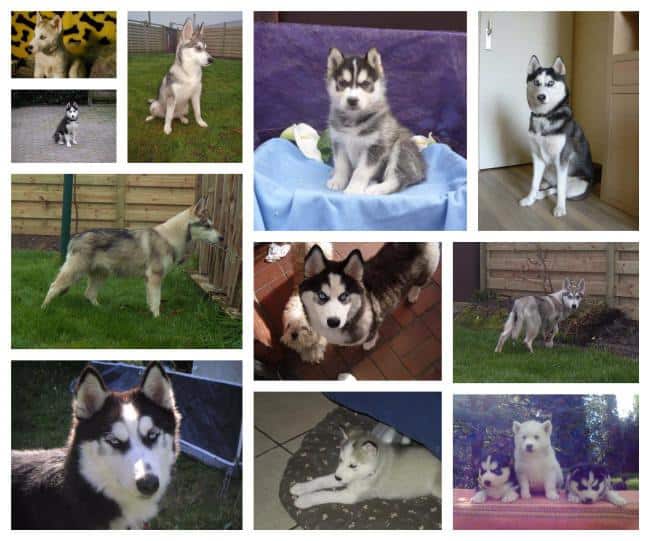The Siberian husky is a beautiful dog breed with a thick coat in multiple color variations. With there blue or brown eyes, they looks very nice. Many people loves the look of this wolf-a-like dog.
Available Siberian Husky pups
 |
Alternative Names for a Siberian Husky
Arctic Husky
Country of Origin
Siberia
History
The Siberian Husky is believed to have been developed by the Chukchi Indians, natives of the region now called Siberia, more than three thousand years ago. The Siberian Husky was first used as a sled dog to pull small loads. Because of its isolation, the breed was kept very pure until the twentieth century, when Alaskans began importing the dogs to use for sled racing. Although largely replaced in dog sledding by the more-competitive Alaskan husky, the Siberian husky continues to be used as a recreational sled dog and companion. It also served as a sled dog with the U.S. military during WW II.
Physical Description
The Husky is a medium-size dog with a compact, muscular body. It is slightly longer than it is tall. It has medium-size, erect ears and almond-shaped eyes that can be brown, blue, one of each, or parti-colored.
Depending on the color of the dog, the nose is black, liver, flesh-colored, or streaked with pink. It is double coated with a medium-length, straight outer coat and a dense undercoat. The tail is well furred. It can be any color, ranging from black to white, with a variety of black or white markings.
Height
The Siberian husky is a large dog, and is about 20 until 23.5 inches tall.
20 to 23.5inches
Weight
He or she weight weight is between 35 pounds and 60 pounds
35 to 60 pounds
Temperament
The Siberian husky is an active, lively dog that is friendly and outgoing with almost everyone. It tends to be independent and is not a one-person dog.
They are pack dogs, and need a owner is the clear leader of the pack. This makes training easier because you will find that your dog respect you, but don’t be surprised if he tests the limits of your position in the pack and take control from time to time.
When this happens, it’s important that you assert yourself as leader. Not by bullying or hitting, but by confirming the rules with clarity and consistency.
Let your dog wait to eat until you and your family has eaten. That is one of the best ways to establish your leadership role. He will view you as the keeper of all valuable resources (food, treats, toys)
Activity Level
This high-energy breed can be destructive , especially when bored or not given exercise. They will demolish a house if they are left long time along alone.
They will dig up flower garden an yards alike, but they can be trained to do this on a specific location or even to stop digging in your yard.
Nonetheless, they can be quite charming with their mischievous and playful nature. They are also quite social and love to show off their talents.
Siberian huskies do not bark, that’s the good news. Here’s the bad news: they do enjoy howling, wich can be very frustrating for your neighbors. Unless you have a properly trained and well exercised husky, the aren’t good pets for apartments.
Watchdog vs family dog
Another caution: although huskies are adored for being friendly and gentle, they make bad watchdogs. They are not overly suspicious of strangers, including burglars. The fact is that they tend to love everybody.
This makes them a ideal family dog!
Best Owner
This breed does well with an active family in a suburban or rural home.
Special Needs
Exercise, fenced yard, job or organized activity, leashed, socialization, training.
Hightlights
- Depending on your climate, siberian huskies are generally low shedders except during the time of the year. This happend two times a year, before winter and before summer.
- Siberian huskies aren’t good for living on a apartment, but some do quite well if they are good trained.
- Siberian huskies are know as escape artists. They can jump over fences, break tie-out chains, slip collars and find any other way to escape. Often this happens when your dog is bored, so be sure that you keep a husky busy.
- A Husky can be destructive. Don’t let him a long time alone without putting him in his cage.
- Huskies love to howl, but they do rarely bark and they will not alert bark if someone comes onto your property.
- Siberian huskies are not a breed for first time dog owners. You have to have a strong character to keep the alpha position in home.
- Siberian Huskies are very curious and can become injured or lost while they are exploring something new.
- Affectionate and good natured describes the Siberian Husky. Generally, they do well with children although young children should never be left alone with any breed. They also get along with people and do well in homes with multiple dogs.
- Siberian husky’s where bred to need very little food to survive. This still applies today and a husky doesn’t need a high level of calories per day.
- Huskies cannot be allowed to run of leash during walks. The can run away and can chase other small animals.
- Due their beauty, Siberian Huskies are one of the most wrongly purchased breeds around. Make sure you have read a lot about the husky or speak with experienced husky owners.
Some lecture below

